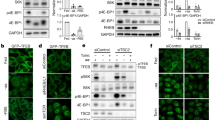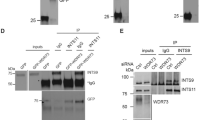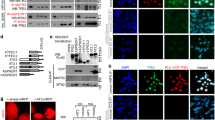Abstract
Birt-Hogg-Dubé (BHD) syndrome is characterized by the development of pneumothorax, hair folliculomas and renal tumors and the responsible BHD gene is thought to be a tumor suppressor. The function of folliculin (Flcn), encoded by BHD, is totally unknown, although its interaction with Fnip1 has been reported. In this study, we identified a novel protein binding to Flcn, which is highly homologous to Fnip1, and which we named FnipL (recently reported in an independent study as Fnip2). The interaction between FnipL/Fnip2 and Flcn may be mediated mainly by the C-terminal domains of each protein as is the case for the Flcn-Fnip1 interaction. FnipL/Fnip2 and Flcn were located together in the cytoplasm in a reticular pattern, although solely expressed Flcn was found mainly in the nucleus. Cytoplasmic retention of Flcn was canceled with C-terminal truncation of FnipL/Fnip2, suggesting that FnipL/Fnip2 regulates Flcn distribution through their complex formation. By the employment of siRNA, we observed a decrease in S6K1 phosphorylation in the BHD-suppressed cell. We also observed a decrease in S6K1 phosphorylation in FNIP1- and, to a lesser extent, in FNIPL/FNIP2-suppressed cells. These results suggest that Flcn-FnipL/Fnip2 and Flcn-Fnip1 complexes positively regulate S6K1 phosphorylation and that FnipL/Fnip2 provides an important clue to elucidating the function of Flcn and the pathogenesis of BHD.
This is a preview of subscription content, access via your institution
Access options
Subscribe to this journal
Receive 50 print issues and online access
$259.00 per year
only $5.18 per issue
Buy this article
- Purchase on Springer Link
- Instant access to full article PDF
Prices may be subject to local taxes which are calculated during checkout






Similar content being viewed by others
References
Baba M, Furihata M, Hong SB, Tessarollo L, Haines DC, Southon E et al. (2008). Kidney-targeted Birt-Hogg-Dubé gene inactivation in a mouse model: Erk1/2 and Akt-mTOR activation, cell hyperproliferation, and polycystic kidneys. J Natl Cancer Inst 100: 140–154.
Baba M, Hong SB, Sharma N, Warren MB, Nickerson ML, Iwamatsu A et al. (2006). Folliculin encoded by the BHD gene interacts with a binding protein, FNIP1, and AMPK, and is involved in AMPK and mTOR signaling. Proc Natl Acad Sci USA 103: 15552–15557.
Birt AR, Hogg GR, Dube WJ . (1977). Hereditary multiple fibrofolliculomas with trichodiscomas and acrochordons. Arch Dermatol 113: 1674–1677.
Fukuda T, Tani Y, Kobayashi T, Hirayama Y, Hino O . (2000). A new western blotting method using polymer immunocomplexes: Detection of Tsc1 and Tsc2 expression in various cultured cell lines. Anal Biochem 285: 274–276.
Guertin DA, Sabatini DM . (2007). Defining the role of mTOR in cancer. Cancer Cell 12: 9–22.
Hasumi H, Baba M, Hong SB, Hasumi Y, Huang Y, Yao M et al. (2008). Identification and characterization of a novel folliculin-interacting protein FNIP2. Gene 415: 60–67.
Hino O, Kobayashi T, Momose S, Kikuchi Y, Adachi H, Okimoto K . (2003). Renal carcinogenesis: genotype, phenotype and dramatype. Cancer Sci 94: 142–147.
Kobayashi T, Hirayama Y, Kobayashi E, Kubo Y, Hino O . (1995). A germline insertion in the tuberous sclerosis (Tsc2) gene gives rise to the eker rat model of dominantly inherited cancer. Nat Genet 9: 70–74.
Kouchi M, Okimoto K, Matsumoto I, Tanaka K, Yasuba M, Hino O . (2006). Natural history of the Nihon (Bhd gene mutant) rat, a novel model for human Birt-Hogg-Dubé syndrome. Virchows Arch 448: 463–471.
Lingaas F, Comstock KE, Kirkness EF, Sorensen A, Aarskaug T, Hitte C et al. (2003). A mutation in the canine BHD gene is associated with hereditary multifocal renal cystadenocarcinoma and nodular dermatofibrosis in the German shepherd dog. Hum Mol Genet 12: 3043–3053.
Nagase T, Kikuno R, Ishikawa K, Hirosawa M, Ohara O . (2000). Prediction of the coding sequences of unidentified human genes. XVII. The complete sequences of 100 new cDNA clones from brain, which code for large proteins in vitro. DNA Res 7: 143–150.
Nagase T, Kikuno R, Ohara O . (2001). Prediction of the coding sequences of unidentified human genes. XXII. The complete sequences of 50 new cDNA clones which code for large proteins. DNA Res 8: 319–327.
Nickerson ML, Warren MB, Toro JR, Matrosova V, Glenn G, Turner ML et al. (2002). Mutations in a novel gene lead to kidney tumors, lung wall defects, and benign tumors of the hair follicle in patients with the Birt-Hogg-Dubé syndrome. Cancer Cell 2: 157–164.
Niwa H, Yamamura K, Miyazaki J . (1991). Efficient selection for high-expression transfectants with a novel eukaryotic vector. Gene 108: 193–199.
Okimoto K, Kouchi M, Kikawa E, Toyosawa K, Koujitani T, Tanaka K et al. (2000). A novel ‘Nihon’ rat model of a mendelian dominantly inherited renal cell carcinoma. Jpn J Cancer Res 91: 1096–1099.
Okimoto K, Kouchi M, Matsumoto I, Sakurai J, Kobayashi T, Hino O . (2004a). Natural history of the Nihon rat model of BHD. Curr Mol Med 4: 887–893.
Okimoto K, Sakurai J, Kobayashi T, Mitani H, Hirayama Y, Nickerson ML et al. (2004b). A germ-line insertion in the Birt-Hogg-Dubé (BHD) gene gives rise to the Nihon rat model of inherited renal cancer. Proc Natl Acad Sci USA 101: 2023–2027.
Roberg KJ, Bickel S, Rowley N, Kaiser CA . (1997). Control of amino acid permease sorting in the late secretory pathway of Saccharomyces cerevisiae by SEC13, LST4, LST7 and LST8. Genetics 147: 1569–1584.
Schmidt LS, Warren MB, Nickerson ML, Weirich G, Matrosova V, Toro JR et al. (2001). Birt-Hogg-Dubé syndrome, a genodermatosis associated with spontaneous pneumothorax and kidney neoplasia, maps to chromosome 17p11.2. Am J Hum Genet 69: 876–882.
Singh SR, Zhen W, Zheng Z, Wang H, Oh SW, Liu W et al. (2006). The Drosophila homolog of the human tumor suppressor gene BHD interacts with the JAK-STAT and dpp signaling pathways in regulating male germline stem cell maintenance. Oncogene 25: 5933–5941.
Togashi Y, Kobayashi T, Momose S, Ueda M, Okimoto K, Hino O . (2006). Transgenic rescue from embryonic lethality and renal carcinogenesis in the Nihon rat model by introduction of a wild-type Bhd gene. Oncogene 25: 2885–2889.
van Slegtenhorst M, Khabibullin D, Hartman TR, Nicolas E, Kruger WD, Henske EP . (2007). The Birt-Hogg-Dubé and tuberous sclerosis complex homologs have opposing roles in amino acid homeostasis in Schizosaccharomyces pombe. J Biol Chem 282: 24583–24590.
Vocke CD, Yang Y, Pavlovich CP, Schmidt LS, Nickerson ML, Torres-Cabala CA et al. (2005). High frequency of somatic frameshift BHD gene mutations in birt-hogg-dube-associated renal tumors. J Natl Cancer Inst 97: 931–935.
Acknowledgements
We thank Drs Fujii H, Tsurui H, Matsuoka S, Wakiya M, Kajino K, Mr Sasahara K and Mr Takagaki T in the Department of Pathology and Oncology for helpful discussions and technical supports. We also thank Ms Ochiai K and Mr Matsunami K in the Division of Radioisotope Research for expert support. We appreciate Dr Maeda M (IBL) for production of antibodies, and Drs Okimoto K, Matsumoto I and Kouchi M (Dainippon-Sumitomo Pharma) and Dr Maeda T (Tokyo University) for helpful discussions. We also thank Kazusa DNA Research Institute for cDNA clones. This study was supported by the grants from the Japan Society for the Promotion of Science (JSPS), from the Ministry of Education, Culture, Sports and Technology of Japan, and from the Ministry of Health, Labour and Welfare of Japan.
Author information
Authors and Affiliations
Corresponding author
Rights and permissions
About this article
Cite this article
Takagi, Y., Kobayashi, T., Shiono, M. et al. Interaction of folliculin (Birt-Hogg-Dubé gene product) with a novel Fnip1-like (FnipL/Fnip2) protein. Oncogene 27, 5339–5347 (2008). https://doi.org/10.1038/onc.2008.261
Received:
Revised:
Accepted:
Published:
Issue Date:
DOI: https://doi.org/10.1038/onc.2008.261
Keywords
This article is cited by
-
Familial multiple discoid fibromas is linked to a locus on chromosome 5 including the FNIP1 gene
Journal of Human Genetics (2023)
-
An mTORC1-mediated negative feedback loop constrains amino acid-induced FLCN-Rag activation in renal cells with TSC2 loss
Nature Communications (2022)
-
Folliculin regulates mTORC1/2 and WNT pathways in early human pluripotency
Nature Communications (2019)
-
Splice-site mutation causing partial retention of intron in the FLCN gene in Birt-Hogg-Dubé syndrome: a case report
BMC Medical Genomics (2018)
-
Establishment and characterization of BHD-F59RSVT, an immortalized cell line derived from a renal cell carcinoma in a patient with Birt–Hogg–Dubé syndrome
Laboratory Investigation (2017)



